| Home Travel Index | First Posted: Dec 29, 2013 Jan 21, 2020 | |
Israel Travelby Debora Johnson Picture Galleries: Baruch Hashem, B'esrat Hashem, Besiyata Dishmaya, Alhamdulillah and Insha 'Allah Israel Trip/Private Guide Graeme Stone Kafr Bir'im, Kafar Bir'em, Kefr Berem and Kfar Bar'am Shtreimel Israel Signs Tekoa, Gush Etzion/Jerusalem This travel page of our trip to Israel does not begin to cover what we saw and experienced in Israel. It does, however, give an overview of the trip. To say that Israel is a vacation would be a misnomer. Our trip to Israel was an exploration into the multi-faceted life existence of persons from universal backgrounds and cultures. It was an attempt to try to understand the political circumstances that surround the Middle East dilemma--which, of course, is an impossibility. One can try to intellectually parse the day-to-day existence of this Jewish State; however, after visiting for a brief two weeks, I can only say that, too, is not possible. I can only come away with intellectual, visual, oral, internal and external glimmers that I viewed through my own cultural prism and had a visceral reaction of "awe". I found this trip to be one of the most exciting--if not the most exciting trip on a multiplicity of fronts--that Bill and I have ever taken. It was a journey through thousands of years of history, through biblical teachings from a myriad of religious groups, through a kaleidescope of cultures that have brought us to the present day. To regurgitate what has already been written about Israel would be futile--so much has already been written and from every perspective. However, this link will give an encapsulation of We started with an itinerary that had been worked out here in the United States by a wonderful company called ITC (Israel Tour Connection) I will not list day-by-day travel but will include an overview of many of the places we visited on our own and while with Mr. Stone. To say Graeme Stone was most amazing would be an understatement. I am going to write a separate page about Graeme Stone--as he was "the trip". Never has the saying "win the hearts and minds" had such clarity! Thank you, Graeme. The following time line should be helpful to help become acquainted with the often tempestuous historical events of the Middle East. It will most certainly punctuate the diversity of the region and bring some modicum of lucidity to today's frenetic political arena. Time line Years
From a religous and cultural perspective Bill and I wanted to try to experience Israel from a Jewish, Christian and Muslim mirror. Although this is an impossibility, we gave it our best. Thus, we visited a potpourri of synagogues, churches and mosques, paying special attention to the history and cultural influences. In the Old City of Jerusalem we visited the Christian, Jewish, Armenian and Muslim Quarters. In the Christian Quarter, there was the Via Dolorosa The Church of the Holy Sepulchre, also called the Basilica of the Holy Sepulchre, or the Church of the Resurrection by Eastern Christians, is a church within the Christian Quarter of the walled Old City of Jerusalem. "The site is venerated as Golgotha (the Hill of Calvary), where Jesus was crucified, and is said also to contain the place where Jesus was buried (the Sepulchre). The church has been a paramount - and for many Christians the most important - pilgrimage destination since at least the 4th century, as the purported site of the resurrection of Jesus. Today it also serves as the headquarters of the Greek Orthodox Patriarch of Jerusalem, while control of the building is shared between several Christian churches and secular entities in complicated arrangements essentially unchanged for centuries. Today, the church is home to branches of Eastern Orthodoxy and Oriental Orthodoxy as well as to Roman Catholicism. Anglican and Protestant Christians have no permanent presence in the Church and some have regarded the alternative Garden Tomb, elsewhere in Jerusalem, as the true place of Jesus's crucifixion and resurrection." It is a few steps away from the Muristan Also, don't miss the Garden Tomb 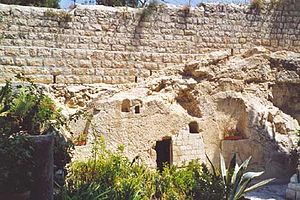 The Garden Tomb Image: Attribution: Dennis1980 at the German language Wikipedia We walked through the restored Jewish Quarter 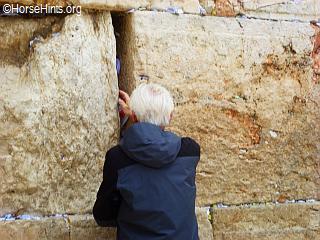 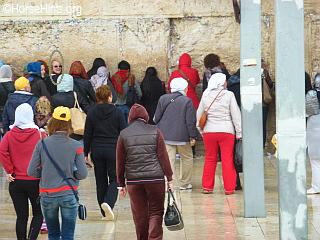 Bill and I placed prayers in the Western Wall. Note: "...Jerusalem (CNN)The Western Wall, one of Judaism's holiest sites, will soon have a prayer space for mixed-gender ceremonies and non-Orthodox Jews following a historical Israeli Cabinet decision on Sunday to finally allow such an area. 'While I know that this is a delicate issue, I think that this is a fair and creative solution,' Prime Minister Benjamin Netanyahu told reporters on Sunday. Many Jews throughout the diaspora rejoiced. 'Today the government of Israel recognized the diversity of Judaism around the world and partnered with us to co-create a space where all can pray at Judaism's most holy site,' said Rabbi Steven Wernick, CEO of the United Synagogue of Conservative Judaism, which has been lobbying for a shared prayer space for more than two decades...." Israel to expand who can pray at holy Western Wall We explored the Rabbinical (Kotel.) We visited the Mount of Olives There was the Garden of Gethsemane  Garden of Gethsemane 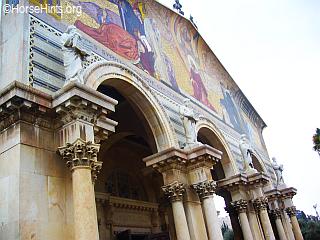 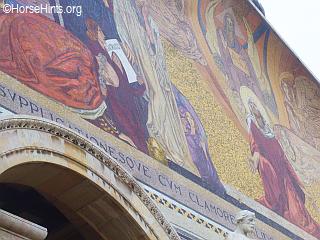 The Church of All Nations, also known as the The Rabbinic Tunnel and massive foundation stones of the Western Wall There is also the newly renovated Israel Museum 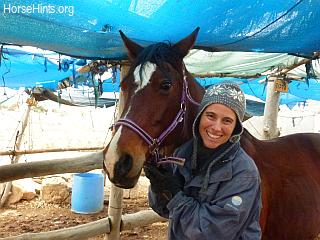 Esther/Owner of Tekoa Stables Tel Aviv: Bill and I guided ourselves all around Tel Aviv and to Jaffa. We stayed in Tel Aviv for three days at the Shalom and Relax Hotel. 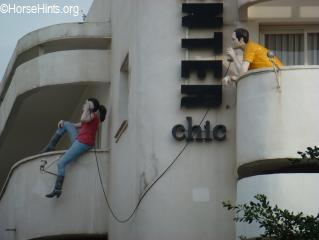  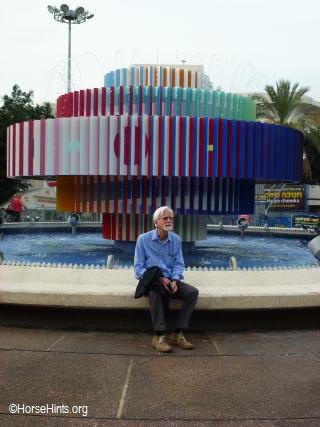 Bauhaus Architecture There is the designated UNESCO World Heritage Site--nicknamed, The White City. Many of the historic buildings are built in the Bauhaus or International style, forming part of the White City of Tel Aviv, a UNESCO-designated World Heritage Site. The 1925 Lederberg house, at the intersection of Allenby Street features a series of large ceramic murals designed by Ze'ev Raban a member of the Bezalel school. The four murals show a Jewish pioneer sowing and harvesting, a shepherd and Jerusalem, with a verse from Jeremiah 31:4, 'Again I will rebuild thee and thou shalt be rebuilt.'" We enjoyed the Carmel Market--the largest bazaar market in Tel Aviv. The market is bordered by Allenby Street "Allenby Street is a major street in Tel Aviv, Israel. It was named in honor of Field Marshal Viscount Allenby. Allenby Street stretches from the Mediterranean sea in the northwest to HaAliya Street in the southeast. It was first paved with concrete in 1914. During the day, it is a commercial street with many small businesses and clothing stores. At night it becomes a hub of nightlife, known for its cafes, pubs and restaurants. Many public buses run along Allenby Street. See the 1925 Lederberg house, at the intersection of Rothschild Boulevard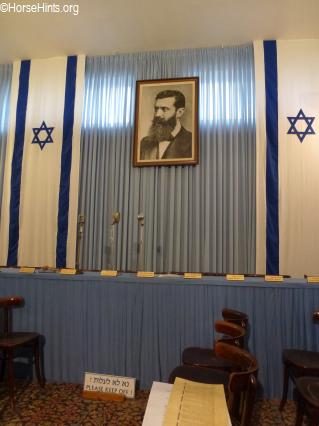 Independence Hall 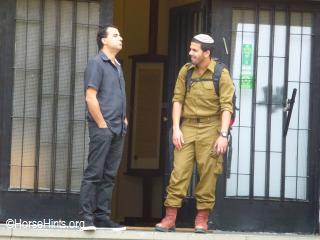  Soldier near Independence hall (left) Meir Dizengoff, First Mayor of Tel Aviv (right) See Rabin Square and the memorial to Yitzhak Rabin and on to Dizengoff.  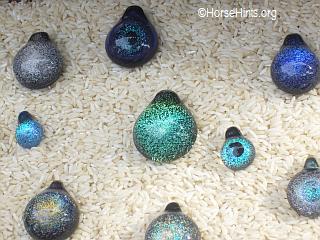 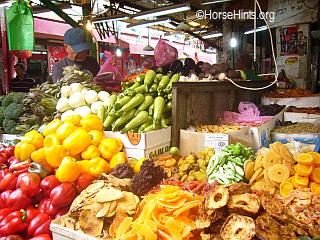 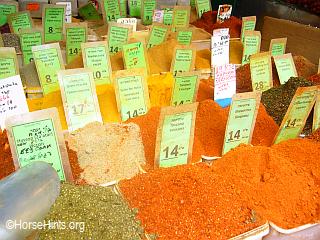 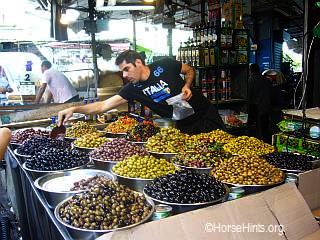 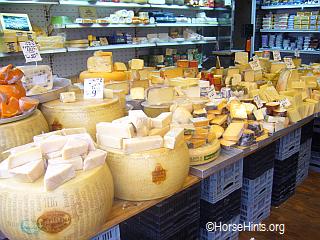 Carmel Market (A bit of a taste!)
After Bill and I explored Tel Aviv together for three days we met Graeme to continue our Israel trip with him for 7 days. He chatted with us to try to discern what was most important to us on this trip. He was beyond terrific. It did not take long for him to figure us out--politics--we want to see for ourselves. We left for the Mediterranean Coast to see ancient history against the backdrop of ancient Caesarea. We saw the amphitheatre, aqueduct and hippodrome. "Caesarea is a town in Israel located mid-way between Tel Aviv and Haifa (45 km), on the Israeli coastal plain near the city of Hadera. Modern Caesarea as of December 2007 has a population of 4,500 people. It is the only Israeli locality managed by a private organization, the Caesarea Development Corporation, and also one of the most populous localities not recognized as a local council. It lies under the jurisdiction of the Hof HaCarmel Regional Council. The town was built by Herod the Great about 25-13 BCE as the port city Caesarea Maritima. It served as an administrative center of Judaea Province of the Roman Empire, and later the capital of the Byzantine Palestrina Prima province during the classic period. Following the Arab conquest in the 7th century, the city had an Arab majority until Crusader renovation, but was again abandoned after the Mamluk conquest. It was populated in 1884 by Bosniak immigrants, who settled in a small fishing village. In 1940, kibbutz Sdot Yam was established next to the Bosnyak village. After receiving word of the Deir Yassin massacre during the 1947-1948 Civil War in Israel, the town was abandoned by the Bosnyak residents. In 1952 a Jewish town of Caesarea established near the ruins of the old city, which were made into the national park of Caesarea Maritima. ..."  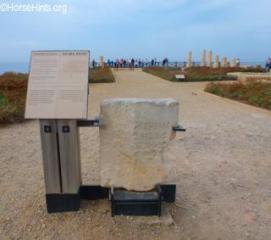 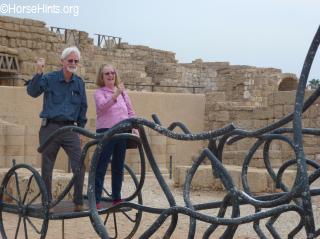 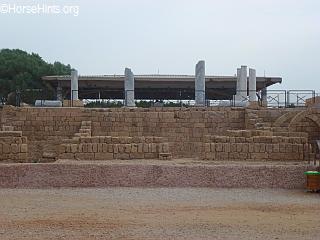 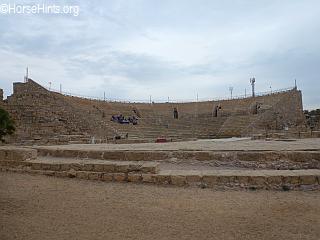 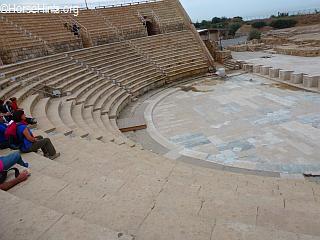 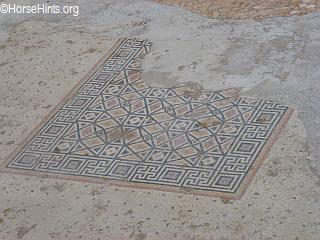 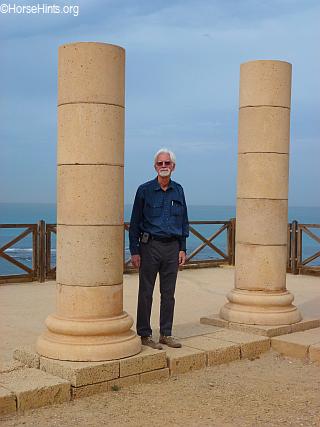 Bill at Caeserea Dalyat al Karmel We visited Tishbi Winery for tastings and chocolate, enjoyed the Carmel region at Makhraka-Karen HaCarmel and continued on to Haifa to spend the night. The hotel was excellent: The Haifa Bay Hotel Haifa Bay Hotel (An Atlas Boutique Hotel) Tishbi Winery: 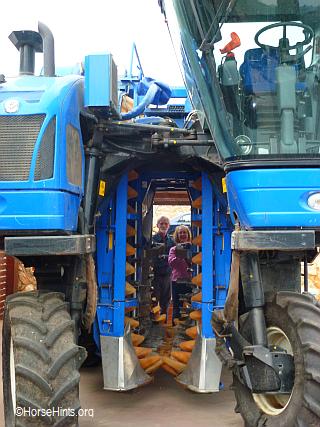 Yikes! 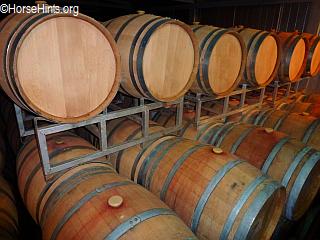 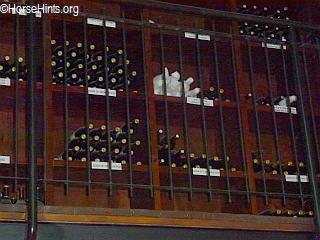  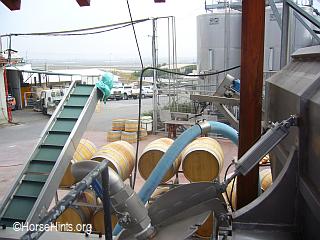 Tishbi Winery: We had a wonderful time here tasting the wines and pairing them with outstanding chocolates. The lovely young women pouring the wine and explaining each tasting were so much fun. We laughed and giggled. There were certain areas we were unable to see because the winery is Kosher. No admittance! Graeme was also enjoying himself although he could not imbibe in the libations only in the enjoyment of the moment. We enjoyed the Bahá'í Gardens. 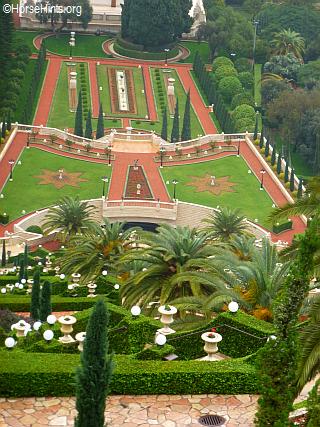 Bahá'í Gardens Continuing on we traveled to Rosh Hanikra where we took the cable car to the grottos of Rosh Hanikra located at Israel's border with Lebanon. "Rosh HaNikra ('head of the grottos') is a geologic formation in Israel, located on the coast of the Mediterranean Sea, in the Western Galilee. It is a white chalk cliff face which opens up into spectacular grottos. The Rosh HaNikra grottos are cavernous tunnels formed by sea action on the soft chalk rock. The total length is some 200 metres. They branch off in various directions with some interconnecting segments. In the past, the only access to them was from the sea and experienced divers were the only ones capable of visiting. Today a cable car takes visitors down to see the grottos. A kibbutz, also named Rosh HaNikra, is located nearby. The Israeli city Nahariya is located about 10 km (6 miles) south of Rosh HaNikra. ..." 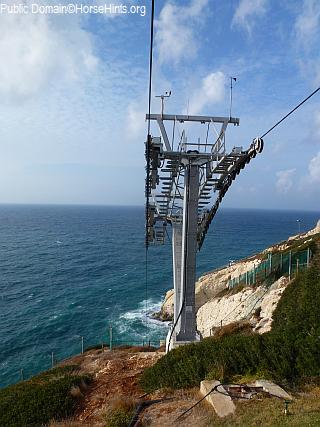 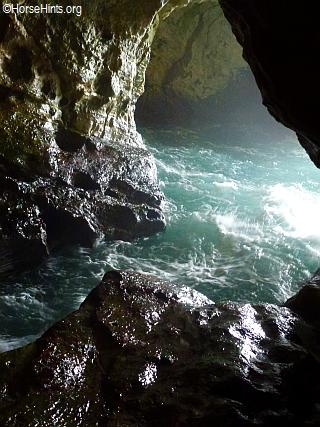 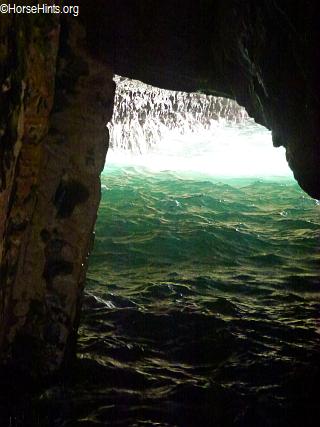 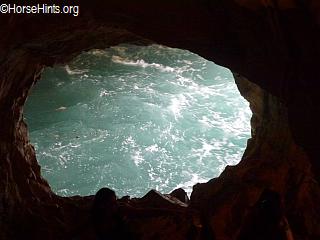  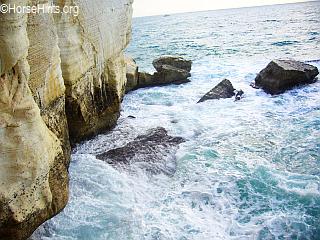 The beautiful grottos of Rosh Hanidra. 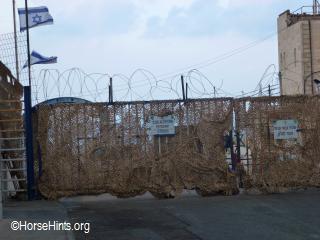   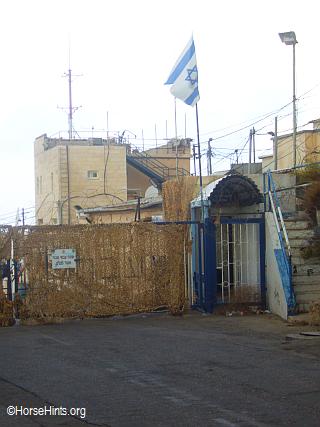 At the Grotto of Rosh Hanidra on the Lebanon Border AccoWe toured historic Acco 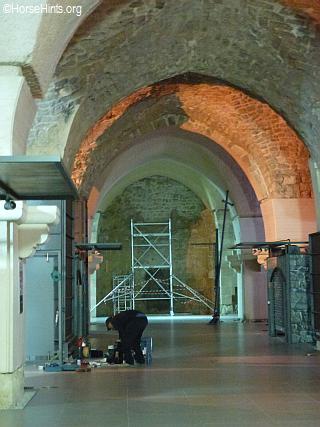 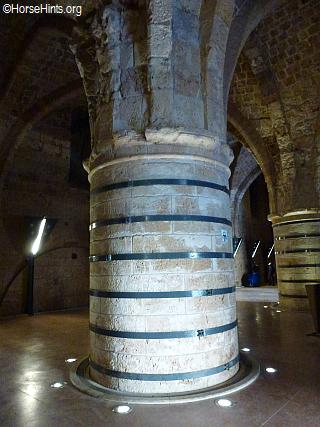 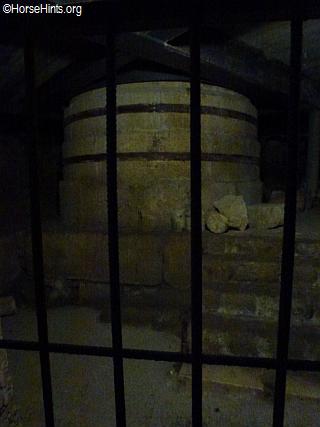 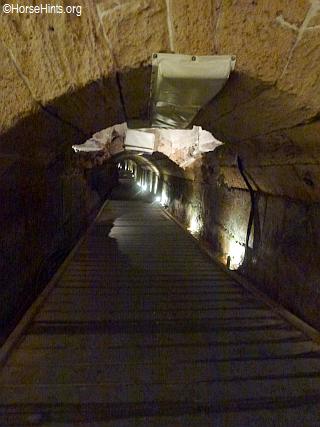  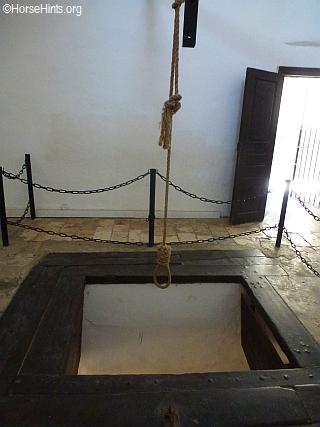 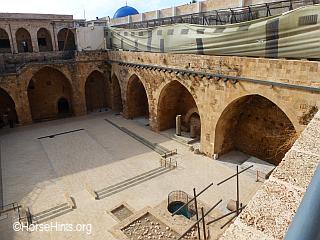  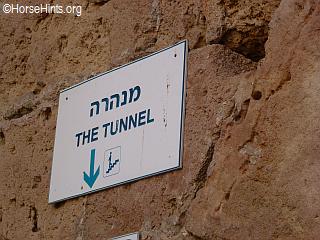 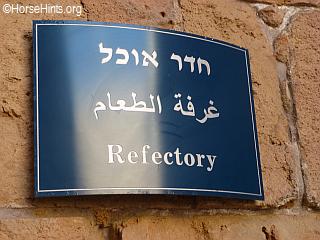  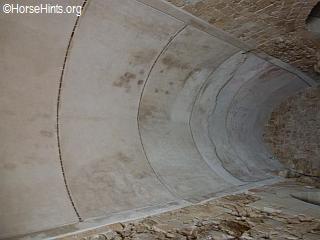 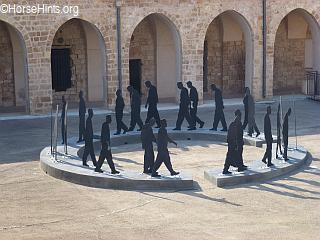  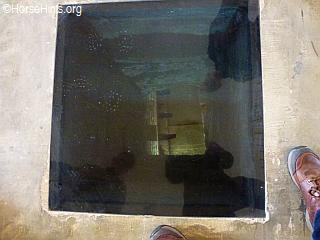 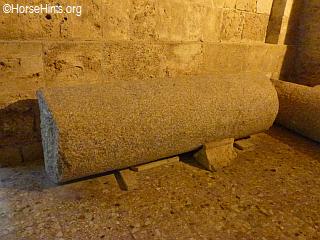 UNESCO Heritage City Travel Israel Continued Travel Israel Continued |